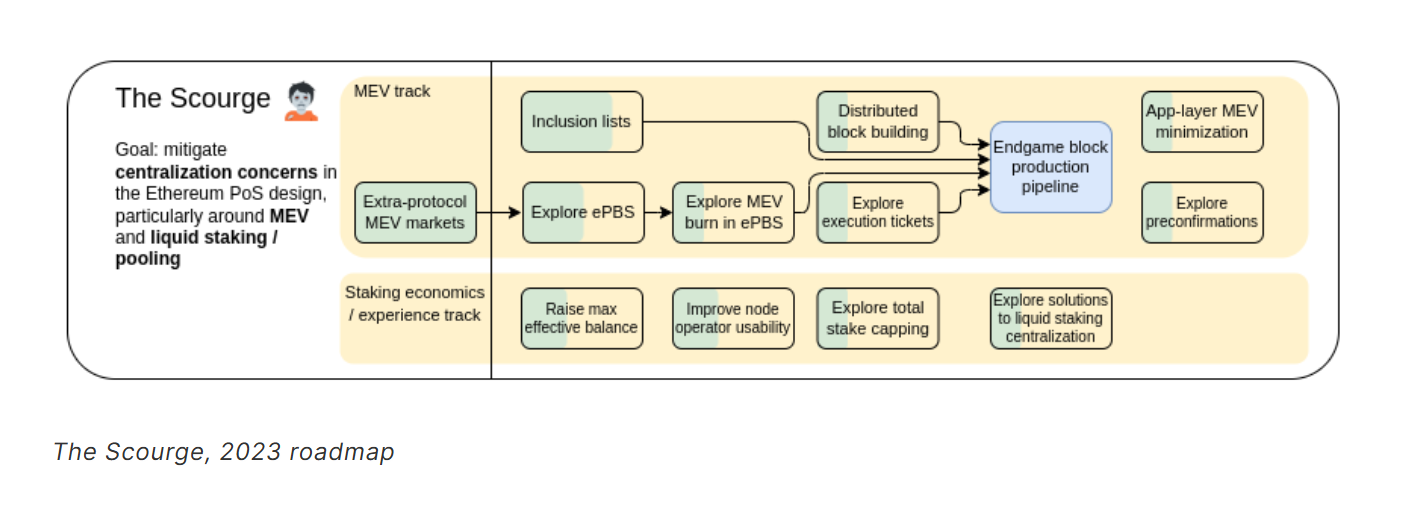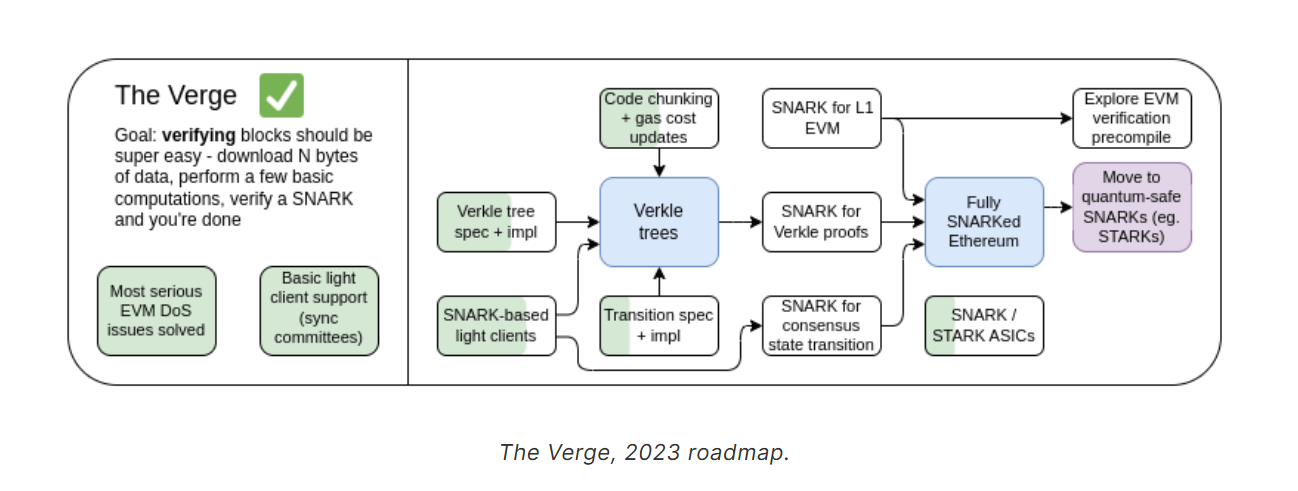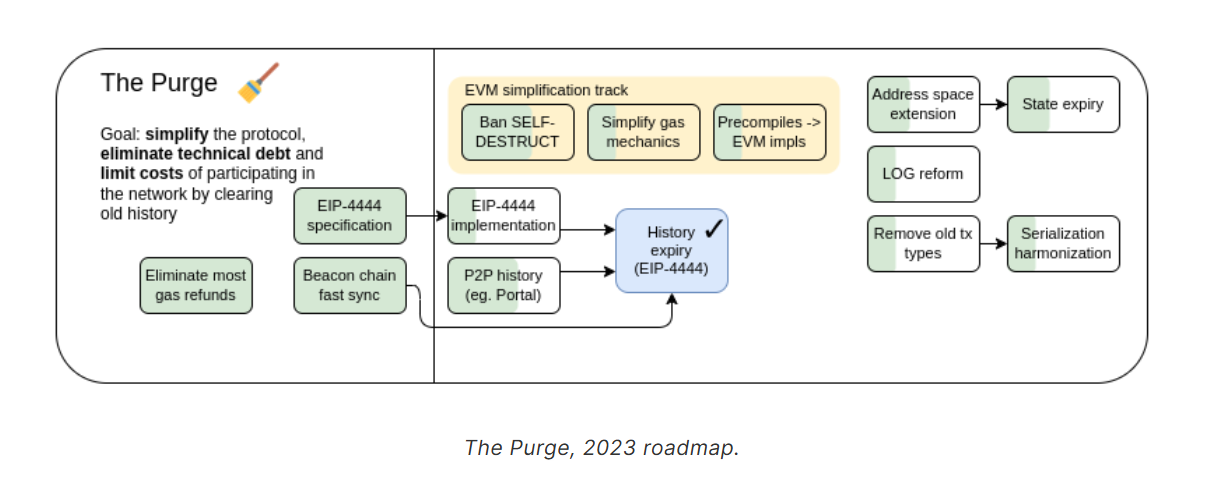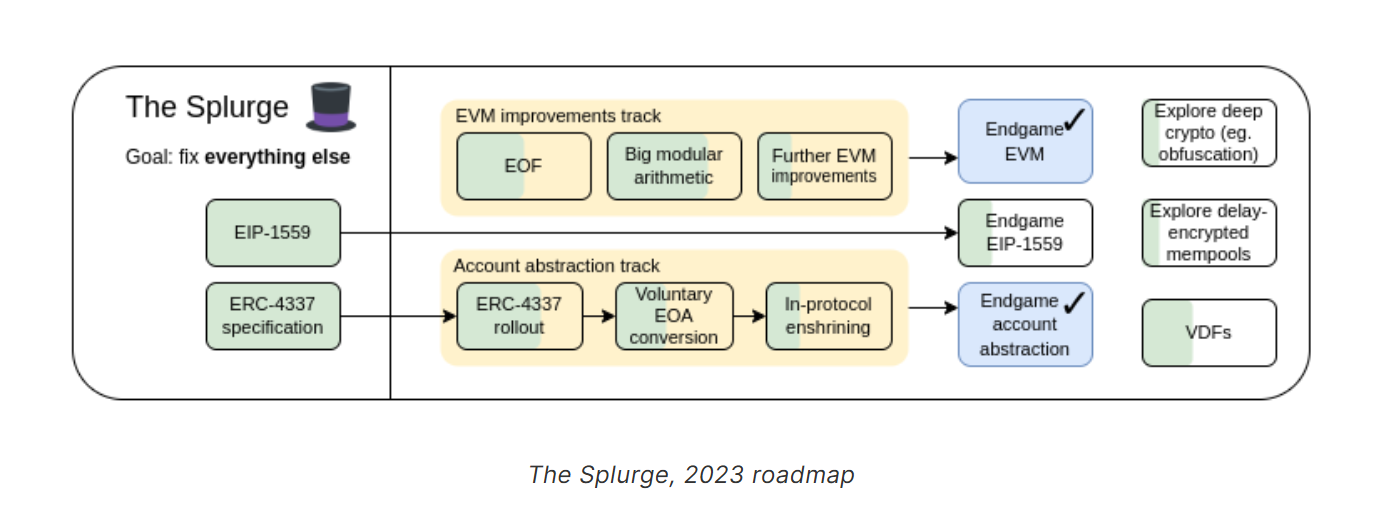The Ethereum Roadmap Cheat Sheet

Ethereum inventor Vitalik Buterin has been on a writing tear this year, with 25 posts published on his blog so far in 2024.
Notably, his latest articles have been part of a series, "Possible futures of the Ethereum protocol," with each post diving deep into a major pillar of Ethereum's roadmap:
- 🔀 Part 1: The Merge
- 📈 Part 2: The Surge
- 🔥 Part 3: The Scourge
- ✨ Part 4: The Verge
- 📤 Part 5: The Purge
- 🎉 Part 6: The Splurge
Unsurprisingly, these are some of the most foundational writings on Ethereum we've seen in its entire history; that said, there's also a lot of info to take in here. Before or even as you dive into these posts, you may find it helpful to have a bird's eye view of what each major upgrade is focused on to better grasp Vitalik's technical writings on the Ethereum roadmap.
Toward that end, here's a quick primer that will get you up to speed on the basics of each of these major upgrades 👇
🔀 The Merge

The Merge, completed in 2022, marked Ethereum's transition from Proof-of-Work (PoW) to Proof-of-Stake (PoS), cutting energy consumption by 99% and enhancing network security through staking. However, according to Vitalik Buterin, upgrades related to The Merge are ongoing.
The goal moving forward is to speed up transaction confirmations, reducing the wait time to as low as 4 seconds. Vitalik shared that another goal related to The Merge will be to lower the staking requirement from 32 ETH to just 1 ETH, allowing more people to participate and help secure the network.
By speeding up confirmations and making staking easier for everyone, Ethereum will become even more decentralized without compromising its security.
📈 The Surge

The Surge is all about making Ethereum faster and more scalable, aiming for over 100,000 transactions per second (TPS). This will be done by optimizing Layer 2s and improving data storage techniques.
A big part of The Surge was EIP-4844, introduced in the Dencun upgrade earlier in 2024, which added “blobs"— new blockspace for storing L2 data.
Next, PeerDAS, expected in the Pectra upgrade in 2025, will enhance how Ethereum manages these blobs, boosting network bandwidth while keeping costs low. Data compression will also help by making transactions smaller, which will further improve the efficiency of rollups.
These upgrades will make Ethereum much more scalable while keeping it decentralized and secure.
🔥 The Scourge

The Scourge tackles a major challenge: centralization risks in Ethereum’s staking and block creation processes.
Right now, building blocks — the process of choosing which transactions go through — favor big players who use advanced algorithms to earn more money. This can lead to transaction delays or manipulation, which isn't good for Ethereum’s decentralization goals.
To fix this, Ethereum plans to split the block-building job into smaller, more manageable parts. One proposal, called inclusion lists, would allow smaller validators to ensure that certain transactions get included in a block, reducing the power of big block builders.
Additionally, ongoing research into encrypted mempools aims to improve security by hiding transaction details until they’re confirmed. A mempool is a waiting area for transactions before they’re added to a block. Currently, anyone can view these pending transactions, which allows block builders to reorder them for profit (a practice known as MEV, or Maximal Extractable Value). By encrypting mempools, transaction details would be concealed until confirmed, reducing opportunities for manipulation.
In addition, Ethereum is looking at ways to reduce the rewards for staking to prevent too much of the network’s wealth from concentrating in the hands of a few large validators. These combined efforts aim to keep Ethereum decentralized and protect users from exploitation.
✨ The Verge

The Verge focuses on making Ethereum easier and cheaper to run, especially for people running their own nodes.
Currently, running a node requires storing hundreds of gigabytes of data, which can be a barrier for many users. The Verge aims to change this by introducing "stateless clients" that don’t need to store all that data. Instead, they’ll rely on cryptographic proofs (either Verkle trees or STARKs) to verify the blockchain.
Stateless clients mean that even a phone or a basic laptop could fully verify Ethereum. This would greatly expand who can help run and secure the network, making it more decentralized. In the long run, Ethereum aims to use cryptographic proofs to verify entire blocks so that even low-power devices can quickly confirm that everything on the blockchain is correct.
The Verge also looks at making Ethereum quantum-resistant by possibly replacing Verkle trees with a more future-proof alternative, ensuring the network can withstand emerging technologies like quantum computing.
📤 The Purge

The Purge looks to make Ethereum leaner and less complex over time.
As blockchains grow, they tend to accumulate more and more data, which every node must store, making it harder for new nodes to join the network. The Purge tackles this problem by reducing the need for nodes to keep all historical data and unused protocol features.
One goal of the Purge is history expiry, where older data — such as transactions and accounts — are stored in a distributed way, similar to how torrent networks work. Instead of every node storing every past transaction, each node would only keep a part of this history, with other nodes storing other parts. This way, Ethereum stays secure and decentralized, but nodes don’t need massive storage to join the network.
Another part of the Purge is state expiry, which addresses the growth of “state data” like account balances and contract storage. This involves automatically removing or archiving unused data over time, making it easier to manage Ethereum’s long-term storage needs.
Moreover, the Purge will be aimed at cleaning up old, rarely-used network features, simplifying the code to keep Ethereum efficient and accessible.
🎉 The Splurge

The Splurge is Ethereum’s “finishing touches” phase, focused on various improvements that don’t fit neatly into other categories but are crucial for enhancing Ethereum’s user experience and technical robustness.
One of the Splurge’s main goals is optimizing the Ethereum Virtual Machine (EVM), Ethereum’s core computational engine, to make it faster and more secure. This includes adding features like account abstraction, which allows users to create flexible, user-friendly accounts with advanced security options. The Splurge also works on improving transaction fee mechanics to keep costs stable and fair, even as network demand fluctuates.
Additionally, the Splurge continues exploring advanced cryptographic techniques that could make Ethereum more resilient to future technological shifts, such as quantum computing. These upgrades aim to future-proof Ethereum, ensuring it remains a reliable platform for decentralized applications in the long run.
🔮 Zooming out
These six major upgrade phases are the pillars of Ethereum's evolution as a meticulously architected, multi-layered system that balances innovation with practicality. These phases aren't isolated but intertwined, with each upgrade balancing immediate needs and future-proofing the network.
Through this layered approach, Ethereum is aligning itself to serve as an excellent foundation for global-scale applications and interactions — the kinds we've all come to expect online, plus ones we’ve yet to even imagine. Along the way, the network's intentional design will ensure that Ethereum remains adaptable, inclusive, and resilient.